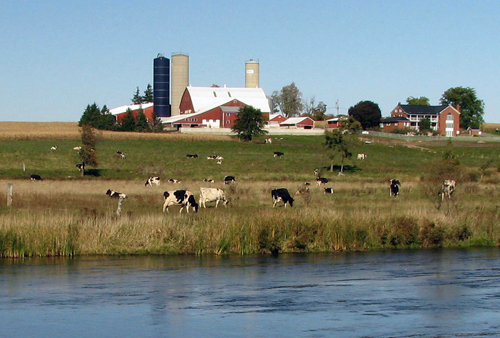By Matt McIntosh, SPARK writer (Students Promoting Awareness of Research Knowledge)

Green technologies such as solar panels and anaerobic digesters sound good on paper, but do they make economic sense for Ontario farms?
That’s what Guelph researchers want to help determine. They’re creating a free online support tool to help farmers make the transition to environmentally-friendly technologies as efficient and cost-effective as possible.
Engineering professor Bill Van Heyst, along with graduate students Stephanie Shaw and Dan Roth, have partnered with the Ontario Ministry of Agriculture and Food, the Ministry of Rural Affairs and the Poultry Industry Council to create a program called the complimentary energy decision support tool (CEDST).
The tool is designed to provide easy access to information about the green technologies available to farmers, the associated costs and which ones would best suit individual farms.
“Each farm is different, so a single prescription just doesn’t work,” says Shaw. “A free one-stop website for this kind of thing will help lessen the headache of building a more efficient operation.”
The researchers describe CEDST as a multifold calculator. Farmers can log on and submit information about their farm, such as the size, location, crop and livestock varieties, and on-farm structures. The program then compiles a list of green technologies that could make the farm more environmentally friendly, outlines the potential costs associated with each option and estimates how much money the farmer could save by investing in them.
For example, farmers who want to generate their own power using a windmill or solar panels, or save on heating and cooling through better insulation can use the support tool to easily compare costs and the return-on-investment period for each option.
In its calculations, CEDST takes into account factors such as current material costs, installation and whether government support exists for the green technology in question.
The program also makes use of Google Earth, allowing farmers to more accurately identify their property lines and assess their building sizes.
To ensure the tool is as accurate as possible, the researchers compare its results with data from other industry-standard renewable-energy calculators on the market.
A substantial amount of information is available in the CEDST database. Shaw and her colleagues have already developed calculators for the program’s solar photovoltaic, geothermal, wind and energy conservation components. Next, they plan to provide details about solar thermal and anaerobic digesters before the program is made available to farmers online.
“There’s substantial connection between the different parts of the CEDST program, which should make it even more accurate and easier to use,” says Shaw. “It really is going to be a very user-friendly and all-encompassing tool, so farmers and homeowners will not have a problem using the program.”
Funding for this project was provided through the Partnership Agreement with the Ontario Ministry of Agriculture and Food, and the Ministry of Rural Affairs.